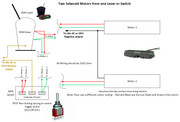If we are talking about Hornby, Seep or Peco etc point solenoids (Wrongly called point motors), one basically has two coils so four wires. It is common practice to wire two of these wires (One from each coil) together to form a "Common". The other two wires are kept separate to pull the point one way or the other. Hornby have (On their point solenoids) joined two of the wires to form a common themselves, so one only has three wires to deal with.
Now solenoids need a brief burst of current just to throw over the solenoid bar, as continual current will overheat the coils and damage them. (They work because the coils act as electro-magnets, which pulls the metal shaft inside the coils towards them, so two coils either end one can pull the shaft one way or the other).
Now we only need a brief burst of current, so we need a switch or means of switching that allows for the burst of current and not a continual current that the majority of switches are designed to give. So if we use a switch, it needs to allow us to give current and then spring itself back to the "No current" position.
These switches are known as "Momentary switches" and are found in adverts where the "On" is shown in brackets. We need an "(On) off (On)" switch, as we need a switch to allow for the point to change one direction or the other.
Now essentually all one needs to do is switch to hear the "Buzz" of the point solenoid move, and then let go. If we buzz for too long we can overheat and damage the coil. So there is a simple electronic device we can buy to prevent this known as a "Capacitor discharge unit", which is a device that not only convines the power to a single burst, but also stores up the power to a stronger boost of burst via the capacitors.
Now there are the odd switch such as the plastic Hornby point switches that we can't use capacitor discharge units (CDU) with because the way those switches are made inside, to throw the switch from one side to the other will first throw the solenoid one way and then the other way due to how they are made inside. (Unlike the (On) Off (On) switch, the Hornby switch does not spring back to the centre, but either sits with the lever all the way one way or all the way the other way if that makes sense? It actually is a useful visual indicator which way the points are set, BUT if we add a CDU, the CDU needs time to recharge after it gives its burst of current, and throwing the Hornby switch from one side to the other does not (Unless we throw them very slowly) give the CDU enough time to recharge to throw the point the way we need it to throw).
I preferred a totally different and even simpler switching method and that is known as the "Stud and probe", where one draws or paints a trackplan on a control panel, and one then drills a hole to show one point route or the other, and places a bolt in the hole (So the nut on the underside holds the electrical wire), and the under wires go to the point on one side of the solenoid or the other (The common wires on all the solenoids are fed back as a common back to tne transformer). The other transformer wire goes either directly, to the "Probe" OR via a CDU (If using one... A good idea to use one) and the probe is ones point changing mechanism. The probe can be a large nail soldered to the wire, or a "Pen-like" thing one makes to sit somewhere on a holder on ones control.panel. When one wants toswitch some points, one then follows the route and simply touches the little bolt heads on the route one wants the train to go. Very cheap to build and very simple to operate.
I hope I have answered the questions, or at least helped answer them.
Now to wire two points to one switch (The "Common" wires will be wired together anyway) one simply wires two of the direction solenoid wires from both points together so when one throws the single point switch, one will either have the route going to pass through the two points or have both points set the other way. Throwing two points the same time ideally needs a CDU which can give a boost in current.
The only thing to avoid is wiring a dead short to the transformer as there is no overload cut out. Cased transformers such as Guagemaster normally have internal fuses, but one does not want to blow a fuse, as they can cost a bit to get them repaired, so always check ones wiring before use so one will avoid a direct short. Other than that, go for it!

Enjoy!
